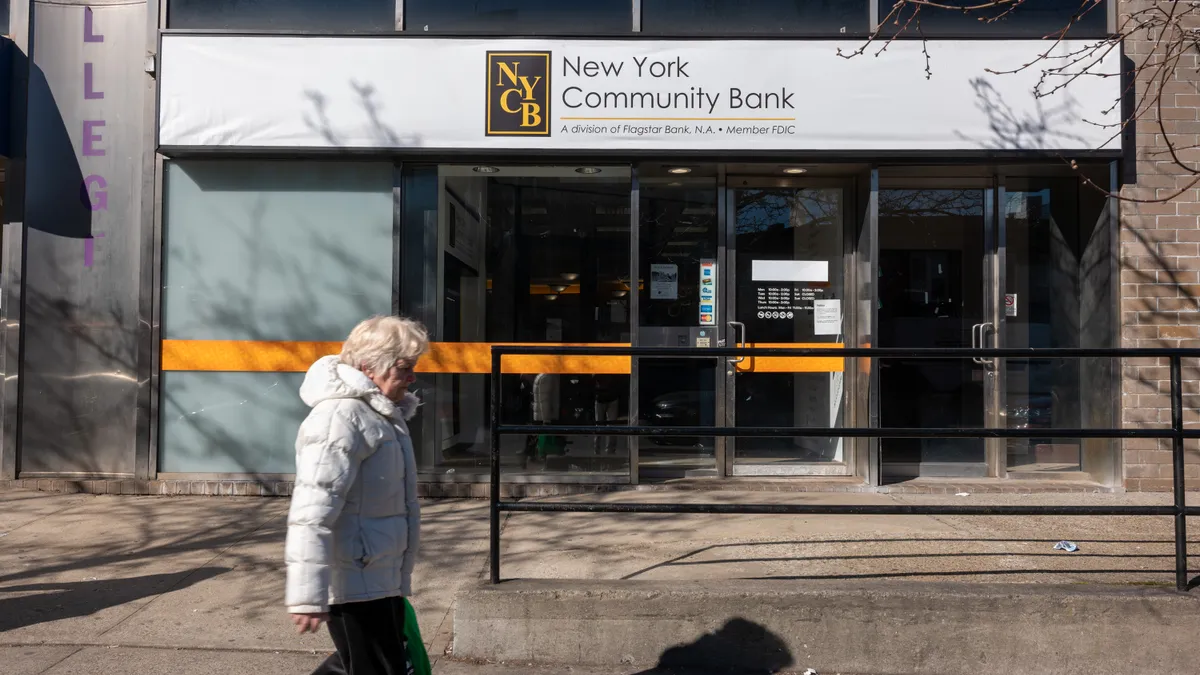Dive Brief:
- New York Community Bank pushed back its projection to turn a profit in 2025, now targeting 2026 for profitability, as the embattled lender tries to execute on its turnaround plan.
- Earlier this year, the bank had projected breaking even or generating a profit of 5 cents per share in 2025, and $1.25 to 1.30 per share in 2026. But on Friday, the bank said it expected to post a loss for 2025, and whittled its profit expectations to 75 cents to 80 cents per share, according to an earnings presentation.
- NYCB recorded another quarterly loss, of $280 million, in the third quarter. The bank also set aside more to cover potential loan losses: Its provision for credit losses amounted to $242 million during Q3, according to an earnings release. For the first three quarters of the year, the bank’s provision totaled $947 million.
Dive Insight:
During the quarter, NYCB also adjusted other projections for the coming years, including dropping its expectation for return on average tangible common equity in 2026 from 7.5% to 8%, to 4.5% to 5%. But the bank has upped its projection for that metric for 2027, from 11.25% to 11.5%, to 12.5% to 12.75%.
The bank, working to reduce its commercial real estate exposure, had about $1 billion in CRE payoffs during the third quarter, said Kris Gagnon, the bank’s chief credit officer, bringing the bank’s year-to-date total to $2.6 billion. Gagnon, speaking during the bank’s third-quarter earnings call Friday, noted the payoffs were at par, and about 34% were related to the bank’s substandard portfolio.
Total CRE loans have dropped 6% year-to-date, NYCB said. The bank has just under $45 billion in CRE loans, and aims to lower that to $30 billion by 2027, NYCB CEO Joseph Otting noted Friday.
CRE loans have been a problem for banks of various sizes. Wells Fargo, for one, could lose $2 billion to $3 billion on its commercial real estate office loan portfolio, CEO Charlie Scharf said Thursday, according to Reuters.
NYCB has recorded $188 million in multifamily net charge-offs this year, according to an earnings presentation. Within its office loan portfolio, the bank has taken $388 million in net charge-offs. For the third quarter, net charge-offs amounted to $240 million.
NYCB’s non-accrual loans increased, totaling $2.5 billion in the third quarter, compared to $1.9 billion in the second quarter. Multifamily made up the majority of non-accrual loans, amounting to $1.5 billion. The bank noted, though, that 68% are current, compared to 61% last quarter.
“We’re exploring all opportunities to reduce our non-accrual portfolio,” Gagnon said. “We’re working with borrowers to work them out, we’re looking at discounted payoffs.” The bank will explore the market to see if there’s an opportunity to sell, but in some cases, executives think “we can do better working them out ourselves,” rather than selling them, he said.
Following the Federal Reserve’s recent rate cut, Otting noted there’s been more interest in rebalancing loans. The bank has moved one large office transaction to be held for sale, and that’s expected to close in November. NYCB has four or five other large office transactions in discussion, he added.
“There is interest, even in the office space, for investors. And some of those we’re selling at where we have them marked, and some of them, we’re taking slight losses,” Otting said. “But overall, we do think that will pick up.”
There’s also been “renewed interest” on the part of those looking to pick up assets in the multifamily sector, he added.
As NYCB seeks to diversify its loan portfolio, the lender is pushing further in commercial and industrial lending and has made a number of hires to bolster that business, Otting said. NYCB has about $16 billion in C&I loans, and aims to grow that to $30 billion in the next three to five years, he said.
The bank is also forecasting higher non-interest expense ranges, expecting to spend more in 2025 and 2026 than it laid out last quarter.
CFO Craig Gifford chalked up some of those tweaks to the new management team gaining better visibility into the business with each month that passes. He noted the “pretty significant action” the bank announced last week, cutting about 1,900 jobs, partly through the soon-to-close sale of its mortgage servicing and third-party origination business to mortgage firm Mr. Cooper.
Gifford said he expects the bank will continue to identify “efficiency opportunities” and reduce costs as NYCB enhances its technology capabilities and business processes.
The bank has also hired veterans from the Office of the Comptroller of the Currency in recent months, as NYCB builds out first, second and third lines of defense related to its risk infrastructure.
“Those were not here in the organization, and as everybody knows, the Category 4 banks, you have enhanced standards you have to adhere to,” said Otting, who ran the OCC from 2017 to 2020.
Earlier this year, Otting noted the bank was “not ready to be regulated by the OCC,” and had “a lot of catching up to do.”
“I really feel good about the people and the direction that we’re going, in that regard,” Otting said Friday. “I think we’ve built a strong bridge to our regulators.”














